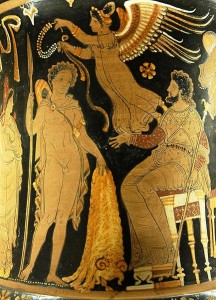
Jason bringing the Fleece to Pelias. Photo by Jastrow (2006) Public Domain Licence
I know Janice suggested I should finish the Dreams of Amarna before getting wound up in The Golden Fleece, but I had a long train journey recently, and started idly thinking about the idea.
So:
Obviously, the scene to do is the one where Medea takes Jason into the grove where the Fleece is kept.. Lots of twisted branches and tree trunks, the sun sinking low in the west, and the Fleece glimmering in the light of the torches.
The first design challenge that occurs to me is that the Fleece will over dominate the picture if I am not careful with all that textured, gleaming gold. On the other hand, gold looks better with a dark, rich coloured background, so I can’t just settle for a daytime scene.
I can ease the problem slightly by dressing Jason and Medea in their best clothes, with rich colours and gold details, and perhaps rather than sunset, have it in moonlight (cue a silver kid moon!), with a line of torches to indicate the approach to the grove.
If I make sure that the Fleece has several shades of gold in it, that may also settle it more happily into place as only part of the panel..
There are several books I can use for reference – Tim Severin built a replica of the Argo and sailed and rowed from Greece to Georgia, which is where Colchis is thought to have been. Robert Graves wrote on the subject. I’ll have little trouble finding other references, either. We’re back to myths, legends, and archaeology…
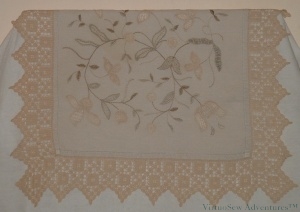
Grandmama's Tea Cloth in needle lace and filet crochet
Grandmama made a lovely linen tablecloth in white-on-white needlelace, but as I couldn’t get any sort of photograph of it, I photographed this small teacloth in ecru shades instead. I think this might have been a practice piece, not in the sense of learning a new skill so much as in the sense of trying it to see whether she enjoyed the technique. I now wonder – in the light of “Stitching for Victory” – whether this was another wartime project, and the various shades of ecru were all that was available.
It looks prettier in real life than in the photograph. I used some of the motifs as inspiration when I designed the Jacobean Firescreen.
Grandmama worked the filet crochet border as well. We have a couple of teacloths with Filet crochet edgings she worked using Mary Card designs. There’s also a crochet lace teacloth that was going to be a bedspread – it is the only occasion that any of us know of, in which Grandmama failed to finish what she started! I’ll try to find the photo of that and scan it to put it up another time.
Scattered around the family, there are also examples of canvaswork, stitched rugs (two quite large ones and a small mat, which is in our hallway), tablecloths, napkins and bedlinen, and a footstool (two footstools, actually!). Not to mention assorted knitwear (I still have, and wear with pride and glee, an intarsia sweater she knitted for me when I was eighteen), and some crocheted work.
She also tried a sort of pressed metalwork, drying flowers and foliage, and Heaven knows what else.
I’ve been told I “collect skills”. Where do you think I inherited that from?
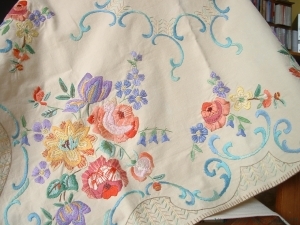
The embroidered teacloth that took three generations to complete!
This heavily embroidered teacloth was begun by my Great Aunt. She either became weary of it or simply felt it she didn’t have time to do it, and she passed it on to her god-daughter.
Who in turn, finished all but a small bit, when she ran out of suitable stranded cotton to do some of the curlicues. And then she passed it on to her god-daughter – me!
I worked something out for the curlicues, and finished the embroidery. And then – Surprise!
I’m reading a book at the moment called Stitching for Victory. It is a fascinating account of the contribution of fabric and stitch to the war effort. It covers tents and uniforms, the Utility mark, Maskelyne‘s misleading camps in the desert, Make Do And Mend. It describes ideas for refashioning and remodelling garments, and repurposing blankets, parachutes and darning wool.
Imagine my surprise when I turned a page among the colour plates and found myself face to face with a teacloth embroidered in a familiar pattern. … It turns out that it was a Penelope kit, and was among those used in rehabilitation of injured soldiers during and after the War!
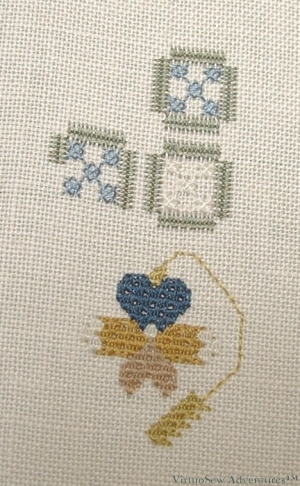
Starting the Spot Sampler
So now I am beginning to do the silk embroidery for the next Thistle Threads Online University Course, the Tudor and Stuart Goldwork Masterclass.
More gorgeous Au Ver A Soie silk thread to play with!
Furthermore, some new stitches! I’m not keen on counted work, so when I saw a chart in the instructions, my heart sank. Then I read the instructions and realised it was going to be a bit more fun than I had thought…
So, most of the silk stitching is to be in Queen Stitch, which I think I have done in canvaswork before, but never at this scale, and never changing its orientation or doing half queen stitches. The square motifs are bordered in Roman Stitch with Rice Stitch in the middle. Apparently in the historical pieces, Queen Stitches are often treated almost as pulled work, creating a lacy pattern of holes between the stitches. It’s quite difficult to pull tight enough, but as you can see from the navy blue petal, I’m beginning to get the hang of it.
The great attraction of this course for me is that we will have animations to show us the complex gold thread stitches that are the main focus of the course. At the end of the course, we’ll get a CD of these animations, so if I forget how to do one, I will be able to learn it again. Furthermore, some of Tricia’s recent posts on The Embroiderer’s Story mention that she has discovered some new stitches during her research trip and she is hoping to add them as a bonus!
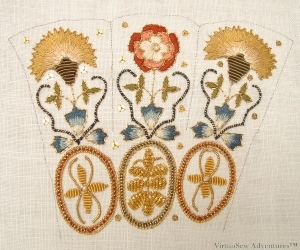
Floral Glove Needlecase - the embroidery finished (I think!)
At least I think it must be. I think the next two months involve the finishing process – adding trims and making the needlecase itself.
I’ve finally got the idea of how the purl should work. It needs to be cut fractionally longer than the distance it is to cover, so as to produce a very slight – a very slight! – curve. This results in a slightly less scrappy look, because the ends of the “beads” of purl aren’t so obvious. It’s not easy to cut accurately – at least, I didn’t find it so, but where I got it right, the sections look much better.
Adding the spangles makes a surprising difference to the final effect – they are so tiny and delicate you don’t expect them to make much difference, but the fragile sparkle really enhances the final effect.
I’m not going to go back and redo the bits that aren’t quite perfect. It will be useful to have the reminder of what I should be aiming for beside the reminder of what I should try to avoid! I’m pleased with what I’ve produced and – although it may not be obvious from the photo – I can see that I have improved over the course.
The difference between this course and a Traditional Goldwork course was that Tracy was less concerned with the techniques of padding and or nue which are familiar from looking at badges or heraldic or ceremonial work. In the Modern Goldwork course, the techniques were more informal and more expressive in an obvious sort of way. It is easy to portray exuberance with threads curling all over the place than when using the design rather than the technique to reflect the emotion.
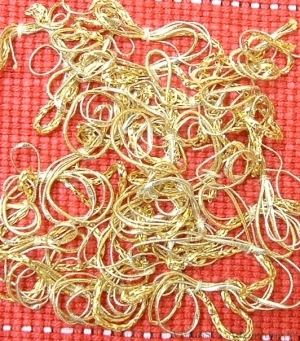
Multistrand Couching
I have chosen this particular sequence to give you some idea of the range of variations available when using essentially the same technique of couched bundles.
For this first panel, we gathered a bundle of several different threads which were then couched down as one, in loose, freestanding loops. This creates an open texture with a high surface. Choosing the types of thread carefully will create a change in the texture.
You can just see in the photograph that the bundle I chose included flat and textured threads. There is even one which looks somewhat like chainette, which changes the reflectance of the whole bundle.
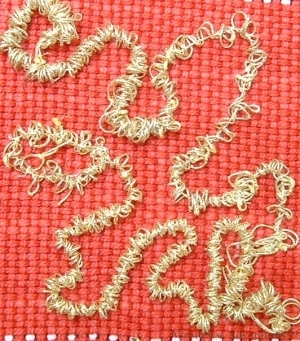
Multistrand Snakes
In this second case, Tracy gave us a specific, four-strand thread to use. Three of the four strands of this thread were gathered on the fourth and the resulting coil couched down as a sort of snake.
The trick here is to use a stranded metallic thread of the right stiffness and springiness to create the neat, regular coils.
You can see that this creates a rough but rather more controlled texture, because the coils are small and neat, rather than loose and floppy like the ones in the first photograph.
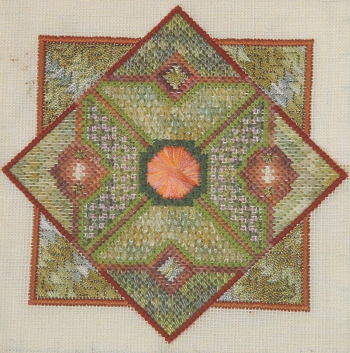
The Canvaswork Knot Garden
This piece arose from my fascination with the knot gardens and parterres of early formal garden design.
It began with the octagonal Rhodes Stitch at the centre. I wanted to use the stitch, but not as part of a repeating pattern. In fact it proved much more difficult to get right than I was prepared for. I now can’t remember how many times I unpicked that wretched octagon!
From that central point a variety of little paths and beds radiate out, using slightly subdued colours again inspired in particular by the colours of herbs. The variegated threads are all from Stef Francis, pearl and soft cottons, and a chainette (in the corners). The stitches include Hungarian Stitch, cashmere stitch, and upright cross stitch (which for some reason turns up a lot in my canvaswork).
I realised that the interesting stitches I was using weren’t producing complete coverage of the canvas, but I decided not to worry about that, as I felt it might lead to something interesting.
As you can tell, what it has not yet lead to is a sensible finishing decision. I cannot for the life of me decide what to do with this. It would be a pity to put it under glass, as that wonderful raised boss of the octagon would lose all of its impact. At the same time, because the coverage is so varied, and because the octagon is such a vulnerable point, turning it into a cushion seems positively half-witted.
Take heed, and design your pieces with their end-use in mind!
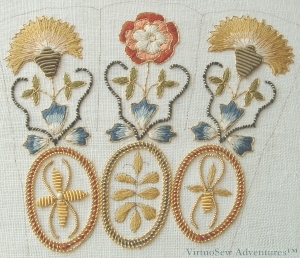
Floral Glove Needlecase - progress
It became clear as I was working on the medallions that I was having more trouble with this than I had with the silk work or couching the Elizabethan Twist, so I thought I would give a sort of “interim report”.
The medallions are outlined with three couched rows of slightly stretched purl purl or lizardine, one of which is wrapped with silk. That in itself was fairly hair-raising (it sounds so simple, but believe me, it isn’t!), and yes, I know that the outlines aren’t perfect and you can see the joins, but they did get neater. The man who said “The more I practice the better I get” was onto something!
The tendrils are slightly stretched lizardine again – stretched by a different amount, just to make sure we paid attention! Then the silk of the motifs is covered with couched lengths of purl, like the calyxes of the carnations. It is surprisingly difficult to cut this stuff accurately – the instructions say to use an old pair of embroidery scissors, which I did, but I find myself wondering whether a sharp craft knife would do the job better. Certainly there would be less chance of crushing the thread. Purl is very fine wire, wound spirally around a former, and when the scissors crush it, the ends are bent out of shape and catch on the thread as you try to thread it through. Since purl is attached by threading it like a bead, this isn’t ideal; even waxing the thread only helps some of the time.
It’s astonishing to see the difference made to the medallion on the left when I added the seed pearl in the centre. I thought it looked neat and finished as it was, but adding the pearl brought the whole thing to life. Now there’s a lesson worth remembering – a small change can make a huge difference to the impression given by a piece. At least embroiderers can undo some of their additions. If you add something to a watercolour that turns out to be a mistake, there’s nothing you can do about it!
Still, I do think I am beginning to get the hang of it. Now it will be interesting to see whether I’ve slid all the way back to the start, or whether, when I continue on the next medallion, I retain some of the improvement I made yesterday.
Grandmama embroidered this lovely lady on a nightdress case for my mother during the War, when they were evacuated to Westmorland. The colours have faded rather now, but it is still beautiful, and the long and short stitch puts me firmly in my place!
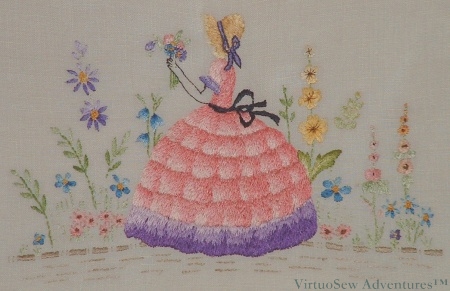
- The Front of “The Lady in the Garden”
The reason it is all so neat is that Grandmama had an embroidery teacher at the time, called Miss Hunter (I mentioned her in an early post). I’m sure Miss Hunter must have been trained at the Royal School of Needlework, because her standards were ferociously high. Grandmama once told me that one of the other ladies in the class at the time was working a Willow Pattern design in single strands of stranded cotton.
The back shows how the colours once appeared, and also how neatly Grandmama worked it all. With the exception of the centres of the hollyhocks, you really can’t be sure you aren’t looking at the front!
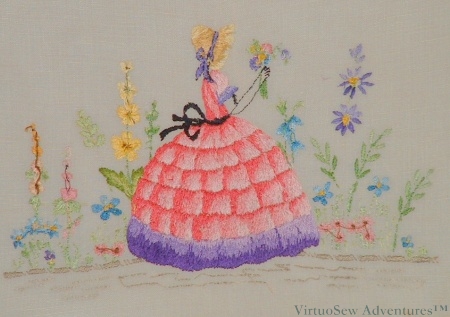
The Back of "The Lady In the Garden"
Miss Hunter’s influence still prevails. A few years ago I taught an engineering friend of mine to do counted cross stitch, and he rapidly picked up our habit of checking that the back was as neat as the front!
As it was such an interesting and useful two days, I thought I would write a bit more about my course with Tracy Franklin on Modern Goldwork. We worked samples of various techniques, each demonstrated by Tracy before we began. I don’t want to make the posts too long, so I will only put two techniques in each post.
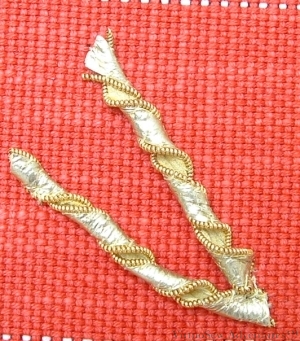
Kid Leather Twists
The base for our Modern Goldwork sampler was a sturdy but loosely-woven cotton upholstery fabric. We began by pulling out evenly spaced threads to mark the fabric into squares. Then in each square we worked a different technique.
The first square had Kid leather strips edged with unstretched pearl purl and then twisted. The twists were then couched in place. It was surprisingly difficult to attach the pearl purl to the edge of the leather, but creates an interesting variation as by twisting the strips, a glimpse of the back of the leather is provided, matte in contrast to the shiny metallised surface that is intended to be seen.
This technique might provide me with the gold in some jewellery for the Amarna panels as a change from simply using gold embroidery thread.
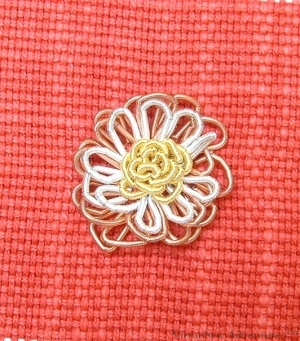
Purl Rose
The second square shows a flower shape made of loops of purl which are threaded onto the needle like beads. There are three different colours of purl, using gradually longer lengths to make larger, slightly floppier petals. The small, closely packed loops in the centre show that this technique could be used to create a very solid, shiny, “curly” texture.
I find myself thinking maybe when I’ve got the Amarna panels done, I could work on a panel about the legend of the Golden Fleece. Just imagine a whole fleece shape covered in that dense, looped surface!













